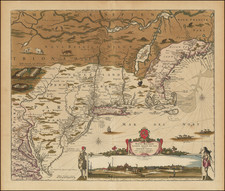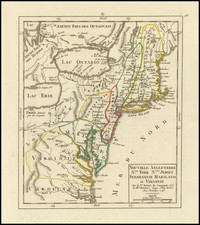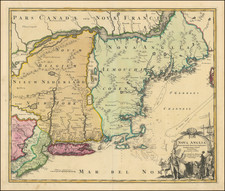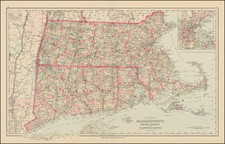Important early Revolutionary-era depictions of Boston, taken from surveys made on the spot by British forces occupying the town.
This plan is attributed to Lieutenant Thomas Hyde Page (1746-1821), a British military engineer who was severely wounded at Bunker Hill. Based on his own "observations" and likely on surveys by his fellow engineer John Montresor, Faden's plan provides one of the best contemporary plans of the attle.
The plan shows Boston proper Roxbury via Boston Neck, and the southern tip of Charlestown, with a detailed treatment of the topography, including Boston's many hills and street plan, with shading to indicate built-up areas. The most valuable information is the careful depiction of the numerous fortifications erected around the town, far more detailed than on almost any other map of the period. Also of interest are "Mount Whoredom" just west of Beacon Hill, so named on account of hosting the town's red-light district; the legend identifying major landmarks such as Town Hall and Faneuil Hall; and the many wharves, some of which remain important features of the Boston landscape.
According to John Montresor,
Thomas Hyde Page served eleven days and was then wounded [at Bunker Hill] and return'd home and had ten shillings per diem settled for life." (Journals, p. 146) The brevity of Page's wartime service in Boston calls into question the extent to which he had to appropriate others' work in order to complete the map. It seems plausible, even likely, that he exaggerated his own contribution by highlighting his own name while referring merely to the "plans of other gentlemen.
First among these "gentlemen" would have been Montresor, who was stationed in Boston from 1774 through the end of the siege in 1776, during which time he was the senior engineer reporting to Generals Gage and Howe. There was certainly precedent for such uncollegial behavior: during the French and Indian War Montresor himself had been caught trying to erase Samuel Holland's name from a major survey of the province of Quebec.
William Faden (1749-1836) was the most prominent London mapmaker and publisher of the late-eighteenth and early-nineteenth centuries. His father, William Mackfaden, was a printer who dropped the first part of his last name due to the Jacobite rising of 1745.
Apprenticed to an engraver in the Clothworkers' Company, he was made free of the Company in August of 1771. He entered into a partnership with the family of Thomas Jeffreys, a prolific and well-respected mapmaker who had recently died in 1771. This partnership lasted until 1776.
Also in 1776, Faden joined the Society of Civil Engineers, which later changed its name to the Smeatonian Society of Civil Engineers. The Smeatonians operated as an elite, yet practical, dining club and his membership led Faden to several engineering publications, including canal plans and plans of other new engineering projects.
Faden's star rose during the American Revolution, when he produced popular maps and atlases focused on the American colonies and the battles that raged within them. In 1783, just as the war ended, Faden inherited his father's estate, allowing him to fully control his business and expand it; in the same year he gained the title "Geographer in Ordinary to his Majesty."
Faden also commanded a large stock of British county maps, which made him attractive as a partner to the Ordnance Survey; he published the first Ordnance map in 1801, a map of Kent. The Admiralty also admired his work and acquired some of his plates which were re-issued as official naval charts.
Faden was renowned for his ingenuity as well as his business acumen. In 1796 he was awarded a gold medal by the Society of Arts. With his brother-in-law, the astronomer and painter John Russell, he created the first extant lunar globe.
After retiring in 1823 the lucrative business passed to James Wyld, a former apprentice. He died in Shepperton in 1826, leaving a large estate.









![Partie De L'Amerique Septent? Qui comprend La Nouvelle France ou Le Canada . . . [Large Great Lakes Inset]](https://storage.googleapis.com/raremaps/img/small/48752.jpg)

![Carte Reduite Des Costes Orientales De L'Amerique Septentrionale . . . contenant L'Isle Royale . . . La Nouvelle Angleterre et la Nouvelle Yorc . . . MDCCLVII [with Plan of Boston Harbor] Plan du Havre de Baston](https://storage.googleapis.com/raremaps/img/small/80006.jpg)


